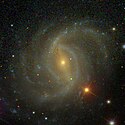NGC 5921
| Galaxie NGC 5921 | |
|---|---|
 | |
| SDSS-Aufnahme | |
| AladinLite | |
| Sternbild | Schlange |
| Position Äquinoktium: J2000.0, Epoche: J2000.0 | |
| Rektaszension | 15h 21m 56,5s[1] |
| Deklination | +05° 40′ 14″[1] |
| Erscheinungsbild | |
| Morphologischer Typ | SB(r)bc / LINER[1][2] |
| Helligkeit (visuell) | 10,7 mag[2] |
| Helligkeit (B-Band) | 11,5 mag[2] |
| Winkelausdehnung | 4,8′ × 4,0′[2] |
| Positionswinkel | 130°[2] |
| Flächenhelligkeit | 13,8 mag/arcmin²[2] |
| Physikalische Daten | |
| Rotverschiebung | 0,004937 ± 0,000003[1] |
| Radialgeschwindigkeit | (1480 ± 1) km/s[1] |
| Hubbledistanz vrad / H0 | (68 ± 5) · 106 Lj (20,7 ± 1,5) Mpc [1] |
| Geschichte | |
| Entdeckung | Wilhelm Herschel |
| Entdeckungsdatum | 1. Mai 1786 |
| Katalogbezeichnungen | |
| NGC 5921 • UGC 9824 • PGC 54849 • CGCG 049-146 • MCG +01-39-21 • IRAS 15194+0514 • GC 4097 • H I 148 • h 1919 • | |
NGC 5921 ist eine 10,7 mag helle Balkenspiralgalaxie vom Hubble-Typ SBbc im Sternbild Schlange und 68 Millionen Lichtjahre von der Milchstraße entfernt.
Sie wurde am 1. Mai 1786 von Wilhelm Herschel mit einem 18,7-Zoll-Spiegelteleskop entdeckt,[3] der sie dabei mit „cB, cL, iR, bM“[4] beschrieb.
- (c) ESA/Hubble & NASA, J. Walsh Acknowledgement: R. Colombari, CC BY 4.0
Hochaufgelöste Aufnahme des Zentrums von NGC 5921, erstellt mithilfe des Hubble-Weltraumteleskops
Weblinks
- NGC 5921. SIMBAD, abgerufen am 11. Mai 2016 (englisch).
- NGC 5921. DSO Browser, abgerufen am 11. Mai 2016 (englisch).
Einzelnachweise
Auf dieser Seite verwendete Medien
(c) ESA/Hubble & NASA, J. Walsh Acknowledgement: R. Colombari, CC BY 4.0
Hubble Spies a Serpentine Spiral Galaxy
The lazily winding spiral arms of the galaxy NGC 5921 snake across this image from the NASA/ESA Hubble Space Telescope. This galaxy lies approximately 80 million light-years from Earth, and much like our own galaxy, the Milky Way, contains a prominent bar. Roughly half of all spiral galaxies are thought to contain bars, and these bars affect their parent galaxies by fuelling star formation and affecting the motion of stars and interstellar gas.
Appropriately, given NGC 5921’s serpentine spiral arms, this galaxy resides in the constellation Serpens in the northern celestial hemisphere. Serpens is the only one of the 88 modern constellations to consist of two unconnected regions — Serpens Caput and Serpens Cauda. These two regions — whose names mean the Serpent’s Head and the Serpent’s Tail, respectively — are separated by Ophiuchus, the Serpent Bearer.
The scientific study behind this image was also split into two parts — observations from Hubble’s Wide Field Camera 3 and observations from the ground-based Gemini Observatory. These two observatories joined forces to better understand the relationship between galaxies like NGC 5921 and the supermassive black holes they contain. Hubble’s contribution to the study was to determine the masses of stars in the galaxies and also to take measurements that help calibrate the observations from Gemini. Together, the Hubble and Gemini observations provided astronomers with a census of nearby supermassive black holes in a diverse variety of galaxies.
Credit:
ESA/Hubble & NASA, J. Walsh Acknowledgement: R. Colombari
Coordinates Position (RA): 15 21 55.76 Position (Dec): 5° 4' 11.59" Field of view: 1.35 x 1.22 arcminutes Orientation: North is 43.8° left of vertical
Colours & filters Band Wavelength Telescope Optical g 475 nm Hubble Space Telescope WFC3 Optical g 475 nm Hubble Space Telescope WFC3 Optical I 814 nm Hubble Space Telescope WFC3 Optical I 814 nm Hubble Space Telescope WFC3 Infrared H 1.6 μm Hubble Space Telescope WFC3.
Autor/Urheber: Sloan Digital Sky Survey, Lizenz: CC BY 4.0
The sky image is obtained by Sloan Digital Sky Survey, DR14 with SciServer.
Angle of view: 4' × 4' (0.3" per pixel), north is up.
Details on the image processing pipeline: https://www.sdss.org/dr14/imaging/jpg-images-on-skyserver/





